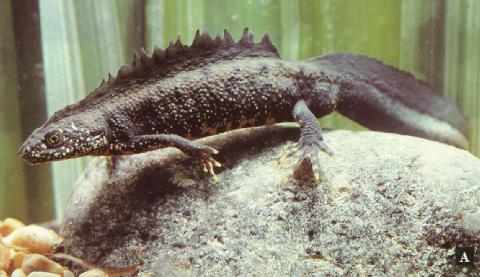
TRITURUS CRISTATUS GROUP: THE CRESTED NEWTS

Male Triturus cristatus. Photo by R. Griffiths.
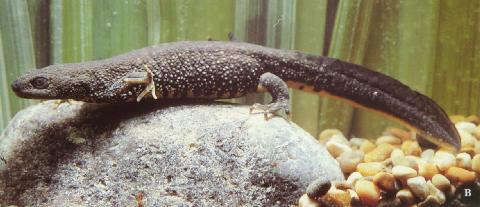
Female Triturus cristatus. Photo by R. Griffiths.
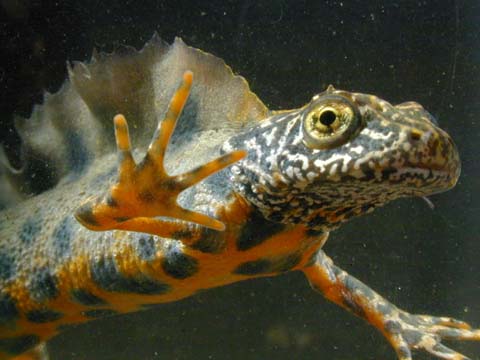
Male Triturus carnifex.
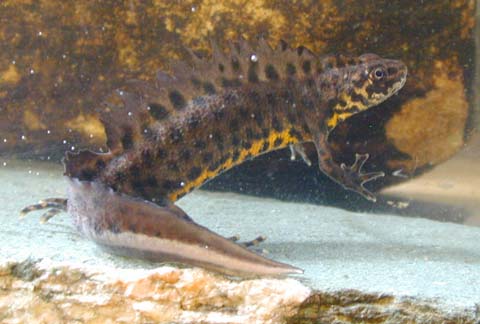
Male Triturus karelinii.
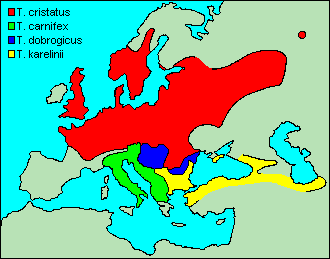
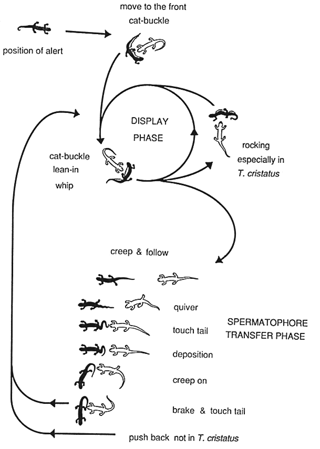
Mating behaviour of all four species: male shown in black, female in white. From Arntzen & Sparreboom (1989).
DESCRIPTION
The crested newts are the largest (to 18cm) and most heavily built newts of the genus Triturus. They have a warty skin, quite unlike the smooth or granular skin of the smaller species. The back is dark brown or black, and there may be white stippling along the flanks. The belly is usually yellow or orange, with large black blotches or spots. The males develop a high, toothed, black crest during the breeding season, and a white band along each side of the tail.
SPECIES
The group was originally considered as one species, but has recently been split into four separate species.
Triturus carnifex: The Italian Crested
Newt
The Italian crested newt has a distribution centred around Italy
and the former Yugoslavia. Females and juveniles may exhibit a
yellow dorsal stripe, which is usually absent in the other
species, and there is little white stippling on the flanks. The
throat is yellow and black with white stippling. The Balkan
populations have recently been described as a separate
subspecies, Triturus carnifex macedonicus .
Triturus cristatus: The Northern Crested
Newt
The northern crested newt is widely distributed across northern
Europe. The wide distribution of this species leads to some
variation in appearance, though white stippling is almost always
present on the flanks, and the throat is dark with similar
stippling.
Triturus dobrogicus: The Danube Crested
Newt
Formerly also known as T. cristatus danubialis, the Danube
crested newt has a restricted distribution around the Danube
flood plains. This species is the smallest and least bulkily
built of the cristatus group. Males have a particularly
high crest, which may extend onto the head.
The distribution of this species is not well known. It has a
small range, and, apart from a small part of the Black Sea coast,
its distribution is bordered by the ranges of other crested newt
species. This leads to hybrid zones where the ranges meet, making
it difficult to establish the exact distribution of the pure
species (Arntzen et al, 1997).
Triturus karelinii: The Southern or
Turkish Crested Newt
The southern crested newt occurs in the far south-east of Europe.
This is the largest species of the group. Belly colouration
usually extends onto the throat. Balkan populations have recently
been described as a new subspecies, Triturus karelinii
arntzeni .
These species are very closely related, and hybrids have been succesfully bred from most combinations of the four species. This group of species, together with the marbled newt, exhibit a chromosomal anomaly leading to a 50% mortality of all eggs produced.
REFERENCES
Arntzen, J. W., Bugter, R. J. F., Cogalniceanu, D., & Wallis, G. P., 1997. The distribution and conservation status of the Danube crested newt, Triturus dobrogicus. Amphibia-Reptilia 18: 133-142.
Arntzen, J. W. & Sparreboom, M., 1989. A phylogeny for the Old World newts, genus Triturus: biochemical and behavioural data. J. Zool., Lond. 219: 645-664.
